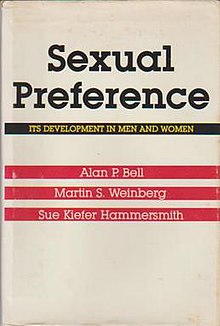Sexual Preference (book)

Cover
|
|
| Authors | Alan P. Bell, Martin S. Weinberg, Sue Kiefer Hammersmith |
|---|---|
| Country | United States |
| Language | English |
| Subject | Sexual orientation |
| Published | 1981 (Indiana University Press) |
| Media type | Print (Hardcover) |
| Pages | 242 |
| ISBN | |
| Authors | Alan P. Bell, Martin S. Weinberg, Sue Kiefer Hammersmith |
|---|---|
| Country | United States |
| Language | English |
| Subject | Sexual orientation |
| Published | 1981 (Mitchell Beazley International Limited) |
| Media type | Print (Hardcover) |
| Pages | 321 |
| ISBN |
Sexual Preference: Its Development in Men and Women is a 1981 book about the development of sexual orientation by psychologist Alan P. Bell and sociologists Martin S. Weinberg and Sue Kiefer Hammersmith, in which Bell et al. reevaluate what were then widely held ideas about the origins of heterosexuality and homosexuality, sometimes rejecting entirely the factors proposed as causes, and in other cases concluding that their importance had been exaggerated. Produced with the help of the American National Institute of Mental Health, the study was a publication of the Institute for Sex Research. Together with its separately published Statistical Appendix, Sexual Preference was the culmination of a series of books including Homosexuality: An Annotated Bibliography (1972) and Homosexualities: A Study of Diversity Among Men and Women (1978), both co-authored by Bell and Weinberg.
Using data derived from interviews conducted in 1969 and 1970 with subjects in the San Francisco Bay Area, Bell et al. attempted to test explanations of sexual orientation put forward by psychoanalysts and social scientists. While homosexual men were more likely than heterosexual men to have felt especially close to their mothers, this had almost no effect on the development of male homosexuality. Poor father-son relationships appeared to be weakly connected to male homosexuality. Homosexual women were more likely than heterosexual women to describe their relationships with their mothers as negative, and to have detached or hostile fathers, but only the latter factor seemed significant. In both sexes, but especially in men, homosexuality was connected to "Childhood Gender Nonconformity", which was a measure partly of behavior more typical of the opposite sex and partly of subjective feelings of masculinity and femininity. Sexual abuse and labeling by others played no significant role. Bell et al. concluded that psychoanalytic explanations of sexual orientation are inadequate. They suggested that while bisexuality is subject to influence by social learning, the development of heterosexuality and homosexuality may have a biological basis, possibly influenced by hormonal factors. They hoped that demonstrating a biological basis to homosexuality would lead to greater tolerance of gay people.
...
Wikipedia
